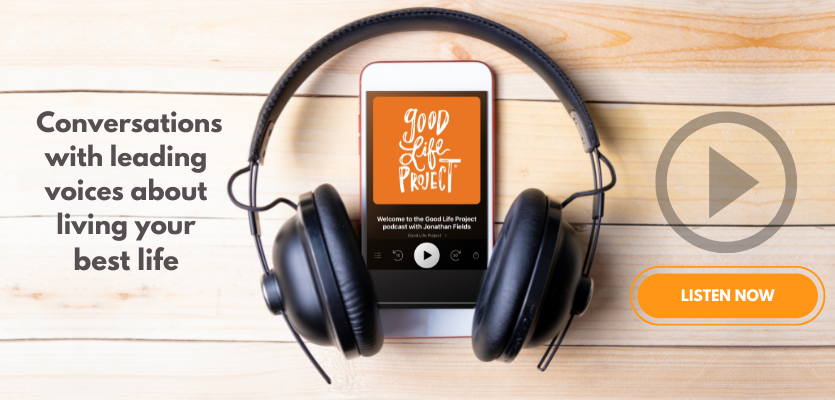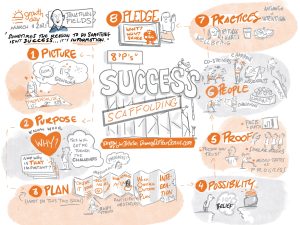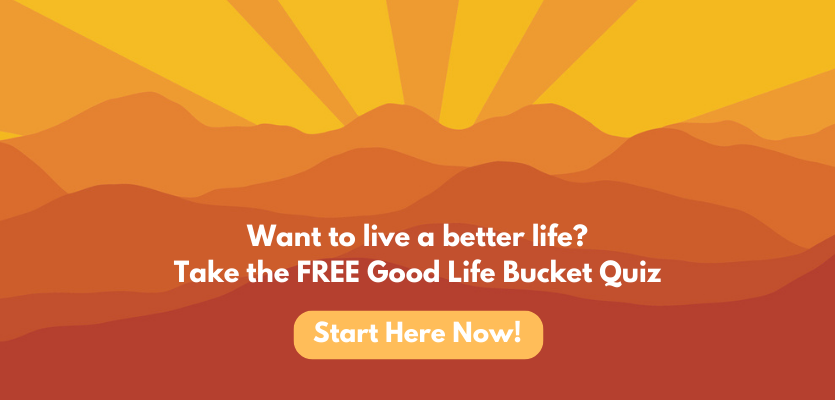The incredible thing about life is that there are so many options — while there are definitely very real limitations and boundaries based on resources, socio-economic status, and culture, we often have a lot more room to maneuver than we give ourselves credit for.
The downside of this is that having all these possibilities is that it’s easy to get paralyzed. Our brains aren’t great when we have so many choices, and this is especially true when it comes to more abstract ideas.
The truth is, no one can tell you what to do with your life. That said, for over a decade, Jonathan has been sitting down with leading voices from science, industry, art, education, relationships, spirituality and more, to explore a powerful question , “How do I live a good life?” While we can’t give you a one-size-fits all answer (that doesn’t exist) … we can share a set of powerful universal patterns and themers that have emerged.
Don’t know what to do with your life? Here’s how to find direction.
Orient towards purpose first.
Humans are wired to operate with a purpose — in fact, researchers Michaéla Schippers and Niklas Ziegler call it “one of the most fundamental human needs.
They call the process of finding out what that purpose is “life crafting”, and recommend thinking through it in seven areas:
“This process [of life crafting] ideally starts with an intervention that entails a combination of reflecting on one’s values, passions and goals, best possible self, goal attainment plans, and other positive psychology intervention techniques. Important elements of such an intervention are: (1) discovering values and passion, (2) reflecting on current and desired competencies and habits, (3) reflecting on present and future social life, (4) reflecting on a possible future career, (5) writing about the ideal future, (6) writing down specific goal attainment and “if-then” plans, and (7) making public commitments to the goals set.” Frontiers in Psychology
This is a great combination of several other people’s research (including the WOOP technique we speak about here), and it makes for a comprehensive overview of the areas of consideration that can point you towards your purpose. If you’re starting from scratch — or have just gotten yourself so turned around you’re not sure what to do, start with some thinking and journaling on these seven areas.
As you’re doing this work, it’s important to remember that your imprint, or purpose, is not necessarily tied to the work that makes you money. While we’ve been indoctrinated with the concept that what you do with your career must be what you do with your life, this isn’t always the case.
Instead of thinking about the question of “What should I do with my life,” from the perspective of trying to find “the right” job or the perfect career from you and then trying to build your life around that, think instead in terms of identity — that which you’re born to do.
“Identity can be conceptualized in terms of two basic sets of self perceptions: (a) perceptions related to skills, characteristics, and competencies, and (b) perceptions related to personal values and goals. Together these two sets of self perceptions inform both individuals’ expectations for success and the importance they attach to becoming involved in a wide range of tasks.” (Educational Psychologist)
To put that in other words, if you can start to get a handle on your identity, you’ll get a good sense of what tasks and work are going to feel fulfilling for you.
Experiment, experiment, experiment.
Professor James P. Carse presents a concept of finite vs. infinite games:
“There are at least two kinds of games: finite and infinite. A finite game is played for the purpose of winning, an infinite game for the purpose of continuing the play. Finite games are those instrumental activities – from sports to politics to wars – in which the participants obey rules, recognize boundaries and announce winners and losers. The infinite game — there is only one — includes any authentic interaction, from touching to culture, that changes rules, plays with boundaries and exists solely for the purpose of continuing the game.” Finite and Infinite Games
Life is the ultimate infinite game — while it does have an end, the whole point of life is living it. Reframing your question of “What do I want to do with my life” in terms of this is immensely freeing. When you think of it in terms of an infinite game, then you free yourself up to experiment. As you start thinking about your identity and work in the world (paid or not), remember that it’s always open to experimentation, and take it with a little lightness. Trust that your “voice of vocation” is calling out to you, and follow where it leads.
“Among his various possible beings each man always finds one which is his genuine and authentic being. The voice which calls him to that authentic being is what we call ‘vocation.’” Jose Ortega y Gasset as quoted in Mastery.
visual story by Lisa Rothstein, drawingoutyourgenius.com
8 steps to take to figure out what to do with your life moving forward.
OK, now that you’ve got some direction for what to do with your life, how do you translate that into the day to day? A lot of people get to this point and call it good, but the truth is, a life is a long time. Just knowing what you want to do with your life won’t make it happen, even if you want it very badly — you need some external supports built into your life to make it happen.
That’s where the Success Scaffolding comes in. This is a framework we’ve developed to help accomplish big, often complicated, but deeply desired and meaningful things in all parts of your life. It will work with any goal you choose to go after, including your ongoing search for what to do with your life, so you can use it for high-level visions like that as well as any sub-quests that come out of your search.
We talk about this every year on the podcast, so you can listen to an in-depth take on this there. But the short version of the Success Scaffolding is:
Step 1: Picture
You want to start by creating a very clear, specific and multi-sensory picture of the outcome you want to create. Both parts of this — the specificity and the sensory elements — are important for making the goal feel real to your brain.
Step 2: Purpose
This is a different level of thinking about purpose than what we talked about above, here you want to think about the reason you’re undertaking this quest. Why does this matter to you? What effects will it have on you, and on others? This will keep you on-track as you move forward, especially in the face of adversity.
Step 3: Plan
Most people start at this step, creating a plan based on impulse, and ignoring the realities of their lives. The problem is, if you don’t accommodate who you are, your resources, privileges, limitations, constraints, and possibilities, you’re setting yourself up for failure. Make sure you make a plan that’s based in reality, and designed for you.
Not sure how to start? Try reverse-engineering from the next end goal — whatever the next step is towards your ultimate life goal. Think about the step that has to happen right before you get there, and then the step before that, and the one before that, and so on, until you get back to the present.
A couple more important things about plans: make sure you build in benchmarks and regular check-ins so you can adjust course as needed, and plan for things to fail. The truth is, even the very best plans are going to have some failures; instead of pretending this won’t happen and then letting them take you by surprise, plan ahead, think about the possible ways to fail, and create preemptive workarounds.
Step 4: Possibility
As we’ve talked about before, brains do funny things when they don’t believe that you can accomplish something. If you doubt that you can actually accomplish whatever it is you’re setting out to do, even subconsciously, your brain is going to do anything and everything it can to keep you from trying, because it considers it a waste of energy. You aren’t going to accomplish the goal anyway, why bother?
The good news is, if you can believe in what you’re doing just 3%, that’s enough to get your brain on board enough to where you can take that first step without immediately self-sabotaging.
Step 5: Proof
OK, how do you create that belief in possibility? By looking for elements of proof. This includes things like data, facts, and demos, as well as testimonials. (Ideally from people who are actually like you, and working on the same thing you are, and not random celebrities.) Information from credible experts works too. The final type of proof comes from your own progress — if you can make a habit of noticing every single tiny win, you’ll start showing your brain that actually, you can do this, and you’ll get this fantastic self-reinforcing cycle going.
Step 6: People
Nobody accomplishes anything substantial alone — much less something huge like figuring out what to do with your life. You have to have people around you. And, you need to have a mix of specific types of people. Try to find people to fill six roles around you.
Role 1: Co-strivers. These are people who are pursuing the same vision as you, working in parallel with you
Role 2: Champions. These are the people who are going to be your cheerleaders, the people you call when things go wrong. They’re there to support you every step of the way.
Role 3: Accountants. These are people who hold you accountable to your plan. It can be a tough role to play (and you may be tempted to avoid having accountants at all!) but they’re super important for keeping you on track.
Role 4: Mentors. Mentors are people who have either been able to get where you want to go, or who have helped a lot of other people get there. They’re there to advise you and help you move forward.
Role 5: Community. This is a group of people who share the way you see the world. They understand you, and while they might not be doing the same thing, like your co-strivers are, they’re still there to support you.
Role 6: Challengers. These are people who you bring in specifically to challenge you along the way. Not because you need to make things harder for the sake of being harder — but to help you challenge your assumptions, your steps, and your actions.
Step 7: Practices
You can’t just wish and hope your way to accomplishing a big goal (although that would be awesome if it worked!) You need to build in repeated practices and behaviors that you do no matter what. When you’re feeling good, when you’re feeling bad, when you’re bored, when you’re excited … you practice. The most powerful practices you can develop are those related to mindset, and especially mindfulness. This helps you become more calm and resilient, and responsive to what’s actually going on around you without being reactive.
One other element to consider here is that of routine and ritual. While they’re both developed the same way — trigger, action, reward — routines or habits are things you do on autopilot, while rituals are things you do with intention. The best way to develop your practices is to make the container a routine, but the practice a ritual. For instance, if you’re going to start a mindfulness breathing practice in the morning, make it an automatic, mindless habit to get up and go sit on your meditation cushion, but show up with intention as you move through the breathing exercise.
Step 8: Pledge
Finally, you want to bring all of this together into a commitment, or pledge. You literally list out, “This is what I’m doing, this is why I’m doing it, these are the actions I’ll be taking, etc”. You can do it as a written pledge, an audio pledge, anything works, but the important part is that you share it, at the very least with the people you have in the six roles.
This is important because of this interesting twist of psychology called the consistency principle, where we’re wired to do things that are consistent with things we have said and done in the past.
“Once people make a decision, take a stand or perform an action, they will face an interpersonal pressure to behave in a consistent manner with what they have said or done previously.” (Influence: Science and Practice)
Let’s Recap:
— Purpose is a fundamental driver for humans. In fact, researchers often consider it a basic need.
— While there’s no clear-cut, objective answer to “What should I do with my life?”, there are science-backed lines of questioning that can point you in the right direction.
— Start by orienting to purpose.
— Then look towards identity.
— Remember that it’s all an experiment, an infinite game that won’t be over until you die.
— Once you’ve got a little bit of a handle on what direction you might want to go in, use the Success Scaffolding to help you continue the journey, and accomplish sub-goals along the way.
— The Success Scaffolding is a research-backed 8-step process for accomplishing big, meaningful goals. The 8 steps are:
Picture – picture what you’re trying to accomplish.
Purpose – get clear on why you’re trying to accomplish it.
Plan – create a realistic plan with benchmarks and workarounds built in.
Possibility – get your brain on board by believing you can accomplish your goal.
Proof – look for proof both outside yourself and in your own actions to augment your belief in possibility.
People – get people in 6 supportive roles around you.
Practices – build mindset practices into your everyday routine and ritual to keep yourself going.
Pledge – publicly share what you’re going to do — the consistency principle means you’re much more likely to do it.
That’s a whole lot of information … but again, “What should I do with my life?” is a big question that can actually last you a lifetime.
We’re excited to be along for the ride with you, and can’t wait to see where it goes, and support you along the way. Join the GLP Newsletter family for more useful deep-dives into subjects like this! We craft each email with an intention to connect, and enjoy getting to know each and every one of you. Join us here.





